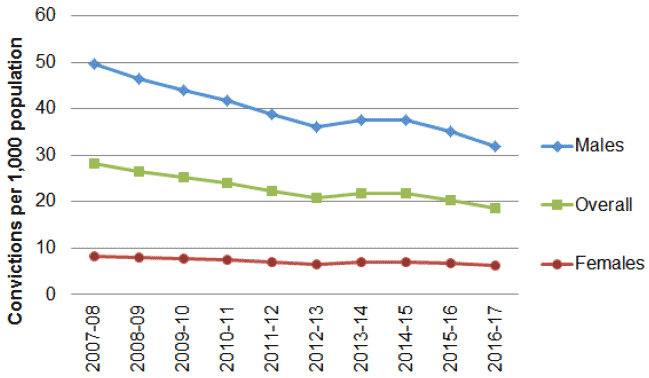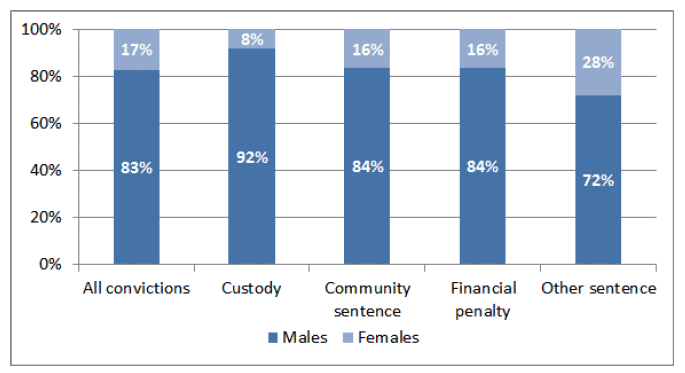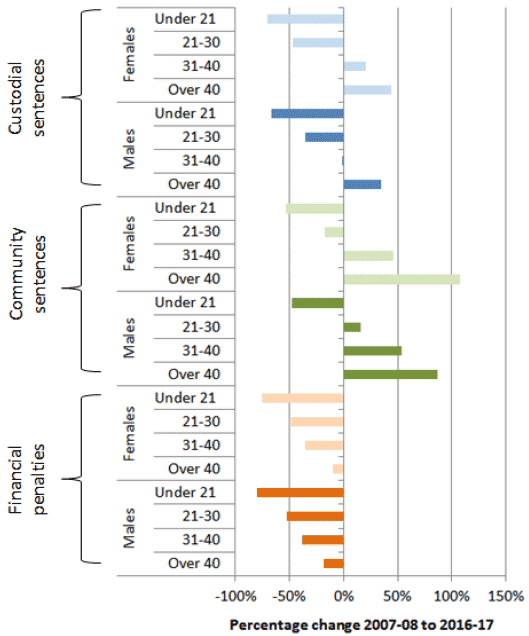Criminal proceedings in Scotland 2016-17: statistics
Statistics on criminal proceedings concluded in Scottish courts and alternatives to prosecution, issued by the police and by the Crown Office.
This document is part of a collection
14. Age and Gender
In 2016-17 there were 19 convictions per 1,000 members of the population (almost 1 in every 50 people). There were more convictions for males at 32 convictions per 1,000 population compared to six for females.
The overall number of convictions per head has declined over the last ten years from 28 convictions per 1,000 population in 2007-08. The number dropped to 21 convictions per 1,000 by 2012-13 and after stabilising temporarily is once again showing a downward trend. The decline has been driven by a decrease for males, down to 32 convictions per 1,000 population in 2016-17 from 50 in 2007-08. The number for females has remained more stable over the ten years, with an overall decline from eight to six convictions per 1,000 population in 2016-17.
Chart 11: Convictions per 1,000 population by gender, 2007-08 to 2016-17

Over the past 10 years, the gap between the number of convictions per 1,000 population for younger people compared to older people has become smaller. This has been driven by a fall in the number of convictions per 1,000 population for younger people, whilst for older people (aged 31 or above), the number has remained relatively stable.
In 2007-08, the age group with the highest numbers of convictions per head was those aged 18-20 with 97 convictions per 1,000 population. Since then, the age with the highest number has increased. In 2016-17, the highest number of convictions per 1000 population was for the 21-30 age group (41 per 1,000). Numbers by age follow similar trends for both males and females, although the highest number of convictions per head for females falls into the slightly older 31-40 age group.
Convictions by gender/age and crime type
Males accounted for 83% of all convictions in 2016-17 (where the gender was known), unchanged from 2015-16. More males than females were convicted in all crime/offence categories except for offences associated with prostitution (71% of all convictions were for females).
Whilst females accounted for 17% of all convictions they accounted for higher proportions of convictions for the following crime types in 2016-17:
- 43% (70 convictions) of other non-sexual crimes of violence. The vast majority of these were for "cruelty to and unnatural treatment of children" convictions ;
- 36% (200 convictions) of all fraud convictions; and
- 30% (1,866 convictions) of all shoplifting convictions.
Compared to older people, a larger proportion of convictions for people under 21 are for crimes of public justice and common assault. For example, more than a quarter (28%) of convictions for females under 21 were for common assault with the corresponding figure for males being 16%. By contrast common assault accounted for smaller proportions of convictions for both men and women aged over 40 (10 and 12% for males and females respectively).
Convictions for motor vehicle offences accounted for higher proportions of convictions for those aged over 40; 42% of males convicted and 40% of females convicted. This compares to the under 21-age group where 21 and 19% of males and females respectively were convicted of motor vehicle offences.
Sentencing by gender and age
Chart 12: Total Convictions and Disposal Type by gender, 2016-17

Overall, males are more likely to receive a custodial sentence than females. This is illustrated by males accounting for 83% of all people convicted in 2016-17 but representing a higher proportion of all custodial sentences (92%). Females were more likely to be issued with an " Other sentence" with 28% of these types of punishments having been given to females compared to the 17% of all convictions that females represent. "Other sentences" are mostly admonishments i.e. a verbal warning from the sheriff.
Please note that sentencing decisions are reflective of a number of factors such as the severity of the crime and whether the individual has offended in the past. In addition, the decision on what type of punishment is reasonable will be based on the personal circumstances of the offender. These statistics do not take account of these factors.
Chart 13: Change in number of disposals by age and gender, 2007-08 to 2016-17

Table 11 illustrates different patterns by age and gender over the last ten years. Chart 13 above summarises the main changes between 2007-08 and 2016-17. In summary it shows that:
- Financial penalties are the only disposal types where the trend is in decline for all age-gender groups, with the largest decreases being for the under 21 year olds for both genders;
- With respect to custodial and community sentences there have been decreases in numbers for those aged "under 21" and "21-30" for both genders with the exception of community sentences for males aged 21-30, which increased by 16% over the ten year period;
- The largest increases have been for those aged over 40, particularly those receiving community sentences. The number of community sentences for females over 40 has increased by 108% since 2007-08, whilst for males the rise has been 87%; and
- There have also been rises in the number of custodial sentences in the over 40s, females up 44% and males up 35%.
Contact
There is a problem
Thanks for your feedback